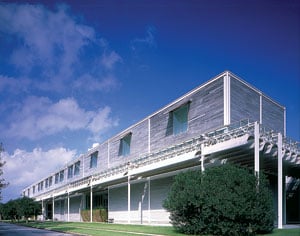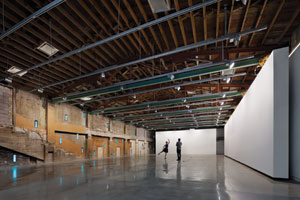Art Everywhere
In the future, we'll all be artists, and all art will look the same.
When people think of Texas, they think of oil, not art. But the gusher at Spindletop that begat an ocean of black crude also begat massive financial support for art. Museums, institutions and collections created by petro-wealth have contributed to Texas’ becoming a contemporary art hot spot that many believe will become more important in the future.
“The Texas art scene in 2030 will exist in convenient, flavorful pill form and will be readily available to all,” says Hills Snyder, a San Antonio artist, writer, and director at gallery Sala Diaz.
Just like The Jetsons.
Houston artist and art writer Bill Davenport predicts, “Judging by the last 20 years, it’s just going to get bigger. But how much bigger can it get? At a certain point, everyone is going to be doing art and no one is going to be doing anything productive.”
The problem with predicting what’s going to happen in 20 years is that it feels like it’s just around the corner. As an art critic for the Houston Press and editor of Glasstire.com, a Texas-centric online arts magazine, I have been writing about Texas art for more than 10 years. I have seen Houston eclipse Chicago as a contemporary art center, and if I am not mistaken, we are creeping up on Los Angeles. New York will remain the No. 1 art scene in America, but in the next 20 years, L.A. and Houston will fight it out for the title of distant second.
photo courtesy Greater Houston Convention & Visitors Bureau

The exterior of the Menil Collection
While Houston is the contemporary art center of Texas, it is by no means the sole source. Dallas, Austin and San Antonio are strong players as well.
Before the great art-market crash in 2008, it seemed every city with artistic aspirations had to have its own art fair. Crash be damned, Dallas launched its fair in 2009, and in its own brave or foolhardy move, Houston is launching a fair in 2011. Part marketplaces, part see-and-be-seen social events, critics view them as embodying everything that is wrong in the art world. Whether contemporary art fairs can survive changing tastes and attitudes, as well as economic upheaval, in the next 20 years remains to be seen. If naysayers are proven wrong, and the Houston and Dallas fairs succeed, Texas cities could become regular stops on the jet-set art consumer’s itinerary, alongside cities like New York, Miami and Basel.
Another predictor of a successful art scene is the cost of real estate, says Houston artist and writer Laura Lark. She cites the Aurora Picture Show, a Houston micro-cinema founded by Andrea Grover in 1998, as an example. Grover bought an old church in Houston’s residential Independence Heights neighborhood for a bargain price and turned it into a theater for artist-made, noncommercial film and video. “Andrea Grover would have never been able to do the Aurora Picture Show in New York or Chicago. Maybe L.A., but she wouldn’t have been able to afford it,” says Lark. The fact that Houston is unzoned didn’t hurt, either. Today the homes on Aurora Street can reach a half million dollars.
Though real-estate prices have risen significantly in the past 20 years, Houston and other Texas cities will likely remain much cheaper than New York, Los Angeles and Chicago. In Houston and other Texas cities, small, artist-run spaces still pop up. Opened in 2008, Skydive, formerly housed in an office space in a decaying Montrose high-rise, has moved to a rented colonial nearby. In Austin, curator and UT doctoral candidate Katie Geha opened SOFA Gallery in the living room of her Hyde Park home in 2009. San Antonio’s Sala Diaz, founded by artist and curator Alejandro Diaz in the living room of his 1920s bungalow in 1995, became a nonprofit in 2006. Early this year in Dallas, TCU curator Christina Rees and artist Thomas Feulmer took over a newly built, never-occupied, soon-to-be-destroyed Washington Mutual Bank building. They organized “Modern Ruin,” a show that was “the only use for the million-dollar building before the demolition process.” The two-day exhibition was rife with commentary on the banking scandal.
Lark believes the size of Texas will be its saving grace. “Sheer physical space is where Texas will always have it over other places. The fact that it takes like 12 hours to drive across this fucking state is what makes this a place that artists can actually use. There’s all kinds of land out there that nobody gives a shit about. The sun will rise and the sun will set,” Lark says, “and we ain’t out of Texas yet.”
Artists always gravitate to cheap space, and if the hinterlands are where art is going, Houston artists like Greg Donner and David Krueger have a head start in West Texas near Terlingua. Donner and Krueger began building a straw-bale building and studios for visiting artists in 2006. Construction mainly takes place during their vacations and, until we all have flying cars, the commute is a little long.
Another key to artistic success is a strong economy that funds art organizations. I would like to think that the number of institutions, nonprofit alternative spaces and artist-run spaces will be increasing, but nothing is certain. “A lot of our museums are supported by oil money,” says Robert Pruitt, a member of the artist collective Otabenga Jones and Associates. “Are we projected to still have oil as an income in 20 years? If not, will energy companies have switched over to some other technology so we can still rely on them? If not, then what will we do?”
So far, there doesn’t seem to be any slowdown when it comes to building and renovating exhibition space. Austin has undergone an unprecedented building boom, with a new building for the Blanton Museum in 2006 and the 2010 openings of the Lake+Flato renovation of the University of Texas’s Visual Arts Center and the Lewis.Tsurumaki.Lewis renovation of the Arthouse gallery. Annette Carlozzi, curator of American and contemporary art at the Blanton, says that by 2030, Austin’s “edifice phase will by then be over, with each major cultural institution firmly ensconced in its own facility, to which its programmatic offerings are attuned.”
photo by Michael Moran

The interior of the new main gallery at Austin’s Arthouse at the Jones Center
In Dallas, the Park at Woodall Rodgers will have connected the Dallas Arts District with Uptown, which will make the arts district less isolated and more of a destination by 2030. In Houston, the Menil’s epic David Chipperfield site plan—with a Drawing Institute, auditorium and green space should be completed by 2030, as well as the Museum of Fine Arts’ new Modern and Contemporary building—is currently five to seven years away.
More predictable than the economy or real estate, Texas demographics will be changing. According to Melissa del Bosque’s article, by 2040 Hispanics will make up 50 percent of the Texas population, with Anglos at 30 percent, African-Americans at 11 percent and other ethnicities at 9 percent. Pruitt tells me, “I’m interested in how the racial and cultural makeup of Texas is changing and how that will play out in the future. What will our museums look like? Will we have Latino directors?”
Whether the Museum of Fine Arts, Houston, will ever have a Latino director remains to be seen. But the museum, which has never been especially avant-garde, is on the cutting edge of contemporary art from Latin America. In 2001, the museum established the International Center for the Arts of the Americas and named Mari Carmen Ramirez as the Wortham Curator of Latin American Art. The museum has organized some groundbreaking shows that rewrote accepted histories of modern and contemporary art. I don’t doubt that its efforts will expand and continue into 2030 and beyond.
Pruitt also wonders what kind of art we will be making in 20 years. “Is Texas going to remain this strongly independent space where artists do all kinds of quirky things?” he asks.
Houston writer Lark describes the Texas art scene of 20 years ago as “this huge kind of apocalyptic playground” with a “kitschy-cool being-a-cowboy thing” that got the Houston art scene national coverage. Today, while there are contemporary Texas artists influenced by Texas culture, “regional art” is no longer a visible factor. As for Texas art 20 years from now, Lark says, “I think that it will have lost any semblance of regionalism.”
The Internet is the force that has the greatest and most profound effect on the Texas art scene—just as it shapes the global art scene. In addition to creating art forms, the most obvious effect of the Internet is that people anywhere can read about and see work by Texas artists, and people in Texas can read about and see work by artists anywhere. This fact has radically changed the artistic landscape. An artist in Cut and Shoot can see what is going on in the newest Williamsburg gallery or check out what people are fabricating on Beijing’s 798 Road. Hipsters in Williamsburg can see what the Cut and Shoot artist is up to. Whether these groups actually search for or stumble upon each other, the potential to influence and be influenced is there.
Let us end on the note of wacky conjecture that is the real reason for reading any prognostication. The ever-prescient Bill Davenport declares that in 20 years “place will cease to exist, and we will all be interacting virtually. But it will be hotter here than in other parts of cyberspace. Of course, in Houston we’ll have the beach next door. It’ll come all the way up the ship channel by then. We’ll be a huge community of disembodied brains lying on the beach sweating, nevertheless, feeling like we are kind of marginalized.”
The future is bright.
Kelly Klaasmeyer is the editor of Glasstire. An artist and writer, she was selected as a Fellow for the 2009 USC Annenberg/Getty Arts Journalism Program and was the recipient of a 2009 Creative Capital/Warhol Foundation Arts Writers Grant.


